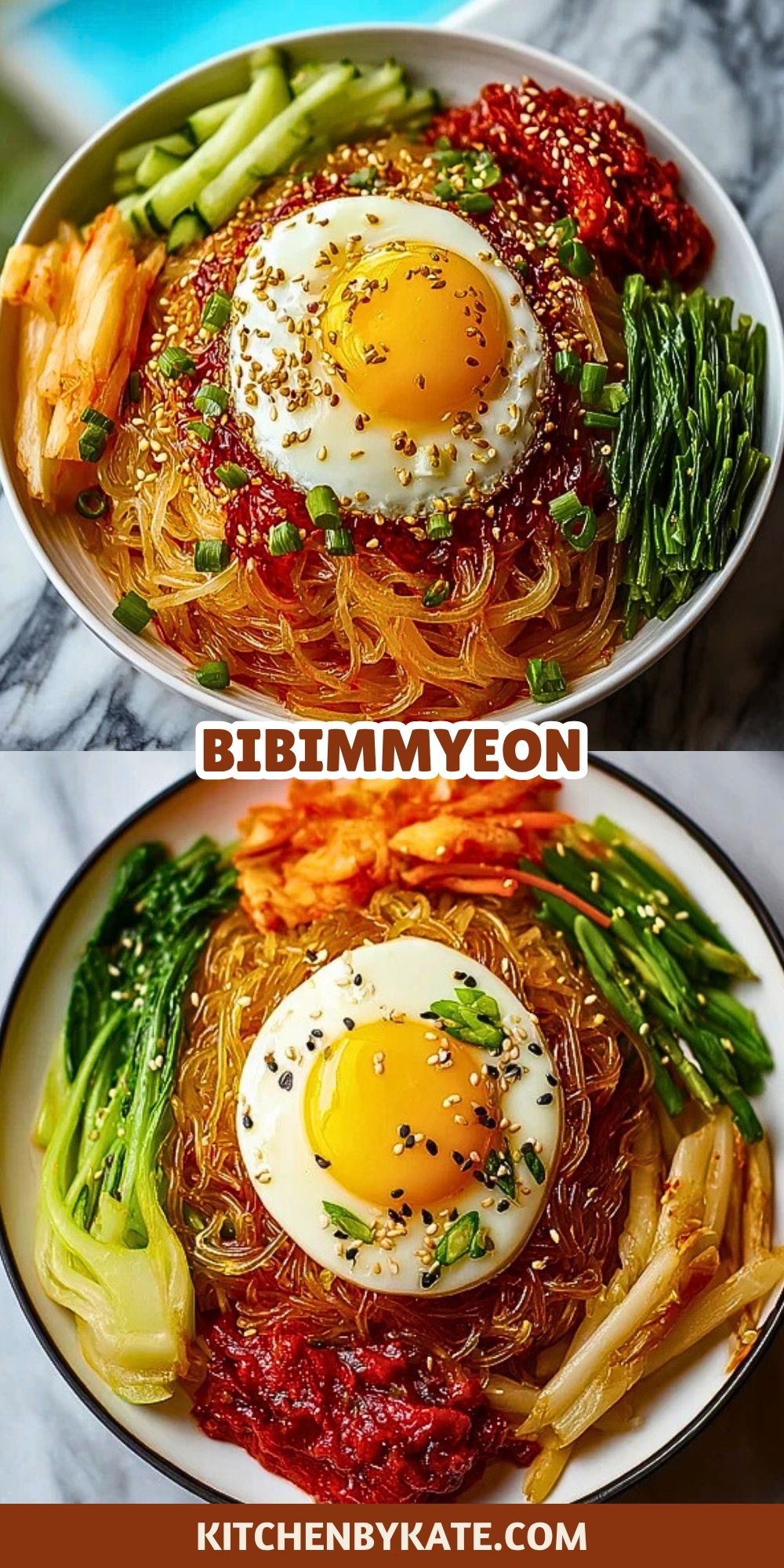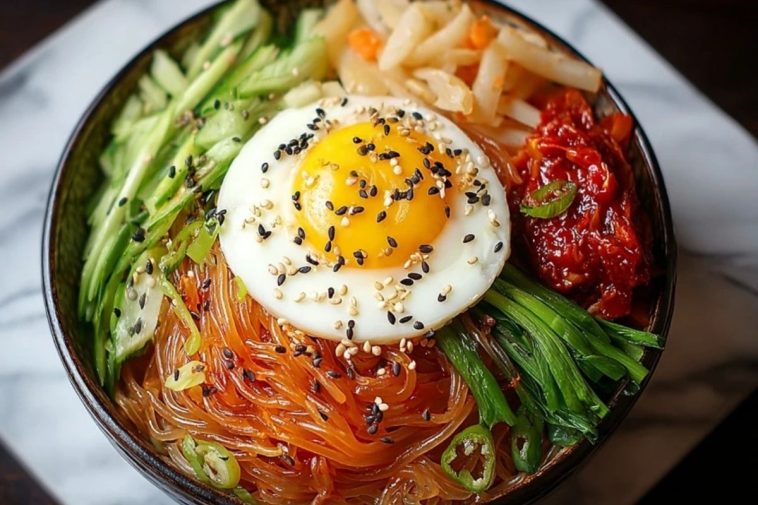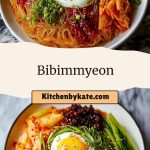A fiery swirl of spicy, sweet, and tangy magic, Bibimmyeon is Korea’s bold answer to cold noodle cravings. Made with springy chewy noodles and a vibrant gochujang sauce, this dish isn’t just a meal—it’s a wake-up call for your tastebuds. Topped with crispy cucumbers, kimchi, and a perfectly cooked egg, every forkful is layered with texture and umami delight.
Perfect for warm days or when you need a refreshing pick-me-up, Bibimmyeon is as quick to prepare as it is addictive to eat. It’s no wonder this Korean staple has become a global obsession among spicy food lovers and noodle fans alike.
Why You’ll Love This Bibimmyeon
Bibimmyeon is the ideal fusion of flavor, ease, and versatility. It’s:
- Incredibly quick to make (under 20 minutes!)
- Packed with punchy gochujang-based flavor.
- Served cold, making it refreshing and light.
- Customizable with your favorite toppings like kimchi, julienned veggies, or protein.
- An ideal base for meal prepping or weeknight dinners.
Whether you’re craving something spicy, need a sidekick to grilled meats, or just want a noodle fix without heating the whole kitchen, Bibimmyeon delivers.
Preparation Phase & Tools to Use
Before diving into the flavors, let’s talk prep. A smooth Bibimmyeon experience starts with the right tools:
- Medium Saucepan: Essential for boiling the noodles just right. You want them bouncy, not mushy.
- Large Mixing Bowl: This is where your noodles get tossed in the magic sauce. Make sure it gives you room to stir well.
- Strainer or Sieve: Quickly drains hot noodles to stop cooking and helps you rinse them under cold water to lock in chewiness.
- Julienne Peeler or Sharp Knife: For slicing cucumbers, carrots, and other veggie toppings thinly and uniformly.
- Tongs or Chopsticks: The best tools for tossing the noodles with sauce evenly without breaking them.
- Serving Bowl or Plate: A wide, shallow bowl makes it easier to arrange toppings beautifully—we eat with our eyes too!

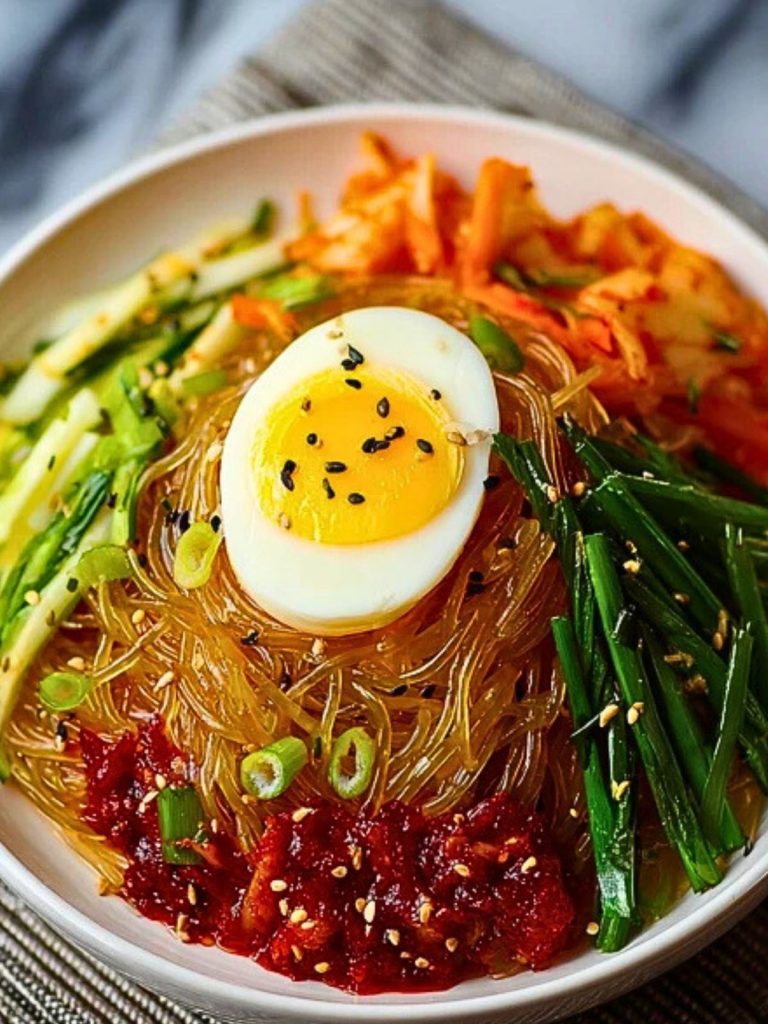
Ingredients for the Bibimmyeon
Each ingredient in Bibimmyeon is a key player in creating that crave-worthy, spicy harmony. Here’s what you’ll need and why it matters:
- Korean Wheat Noodles (Somyeon or Bibim-style noodles): These thin, chewy noodles are the backbone. Their texture holds the sauce perfectly.
- Gochujang (Korean Red Chili Paste): This is the soul of Bibimmyeon—spicy, sweet, and fermented for deep umami.
- Rice Vinegar: Adds brightness and cuts through the heat, balancing the sauce.
- Soy Sauce: A dash brings savory depth to the gochujang.
- Sesame Oil: Gives the noodles that nutty, aromatic finish.
- Sugar or Honey: A little sweetness rounds out the spicy edge.
- Garlic (minced): Adds pungent kick and warmth.
- Cucumber (julienned): Cool, crisp contrast to the fiery noodles.
- Carrot (optional, julienned): Adds color and crunch.
- Kimchi: Fermented tang and spice complement the gochujang.
- Boiled Egg: Classic topping for creamy richness and visual appeal.
- Scallions and Toasted Sesame Seeds: Garnish with texture, color, and flavor.
How To Make the Bibimmyeon
Step 1: Cook and Chill the Noodles
Boil the noodles according to package instructions, usually around 3-4 minutes. Drain and immediately rinse under cold water to stop cooking and firm them up. Toss with a drizzle of sesame oil to keep them from sticking.
Step 2: Make the Spicy Bibim Sauce
In a bowl, mix gochujang, rice vinegar, soy sauce, sugar (or honey), minced garlic, and a touch of sesame oil. Adjust sweetness or spice to taste.
Step 3: Toss the Noodles in the Sauce
Place the cooled noodles into a large bowl and pour in the sauce. Toss thoroughly with tongs or chopsticks until the noodles are evenly coated and gleaming red.
Step 4: Prepare the Toppings
Slice cucumbers and carrots into thin strips. Cut scallions. Peel the boiled egg and slice in half. Have kimchi ready to go.
Step 5: Assemble and Serve
Pile the saucy noodles into a serving bowl. Neatly arrange the toppings on top: cucumbers, carrots, kimchi, egg halves, scallions, and a sprinkle of sesame seeds. Serve immediately and mix everything together before eating!
Serving and Storing Your Bibimmyeon
Bibimmyeon is best served immediately once assembled, as the noodles are meant to be cold and refreshing. Mix the toppings in just before eating to enjoy all the contrasting textures in their prime—crisp cucumbers, spicy kimchi, creamy egg, and chewy noodles.
If you’re meal prepping, store the sauce and noodles separately to keep the texture fresh. Noodles can be rinsed in cold water again before serving, and toppings should be added at the last minute. Store leftovers in an airtight container in the fridge for up to 2 days, but keep in mind that the noodles will soften over time.
Frequently Asked Questions
How spicy is Bibimmyeon?
It depends on the amount and brand of gochujang used. You can adjust the heat by adding more or less of it, or even mixing in a bit of honey to mellow the flavor.
Can I make this dish gluten-free?
Yes! Use gluten-free soba or rice noodles, and check that your gochujang and soy sauce are certified gluten-free.
Is Bibimmyeon served hot or cold?
Traditionally, Bibimmyeon is served cold. The cool temperature enhances its refreshing quality and balances the spicy sauce.
What can I use instead of gochujang?
While gochujang is ideal, you can try a mix of chili garlic sauce with a touch of miso and honey if needed—though the flavor won’t be quite the same.
Can I add protein?
Absolutely! Grilled chicken, tofu, shrimp, or bulgogi beef are all great additions that make it more filling.
Do I need to include kimchi?
It’s highly recommended for that fermented kick, but not essential. You can substitute with pickled radish or even slaw for crunch.
Want More Noodle Dish Ideas?
If you’re hooked on the bold, vibrant taste of Bibimmyeon, you’ll love exploring these other flavorful dishes:
- Easy Thai Red Curry Dumpling Soup for a creamy, spiced comfort bowl.
- Fiery Chicken Ramen with Creamy Garlic Sauce if you love the heat with a creamy twist.
- Simple Asian Ground Beef Noodles Recipe for a meaty, quick noodle fix.
- Creamy Cajun Sausage Pasta with smoky spice and a southern kick.
- Garlic Butter Beef Cheesy Bowtie Pasta if you’re craving fusion-style comfort.
Save This Pin For Later
📌 Save this recipe to your Pinterest dinner board so you can come back to it any time:
Follow Kitchen By Kate on Pinterest for more globally-inspired dishes, quick noodle bowls, and everyday favorites.
I’d love to hear how your Bibimmyeon turned out! Did you keep it classic or add a personal twist? Drop your tips, questions, or favorite toppings in the comments below—your version might inspire someone else!
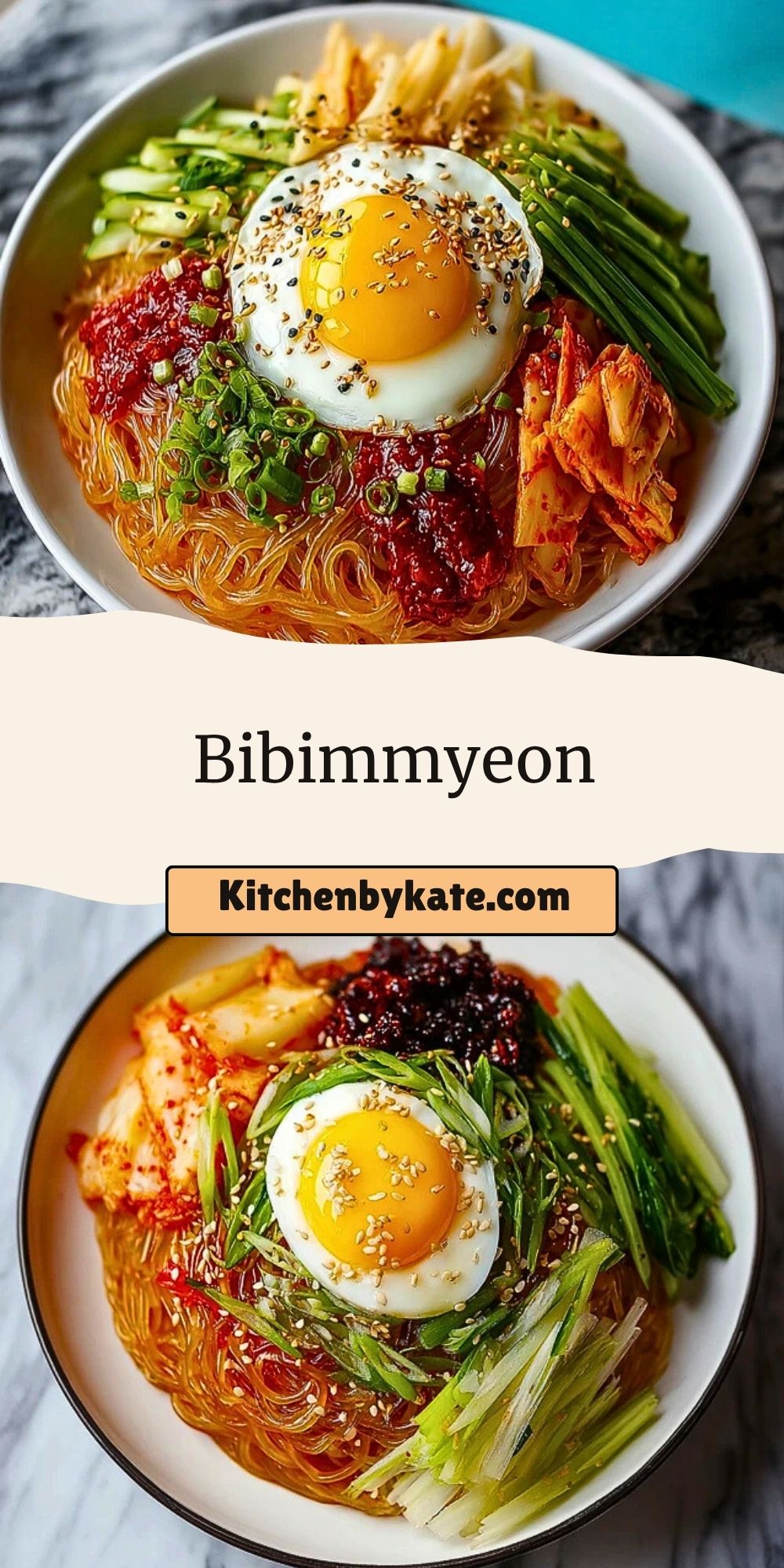
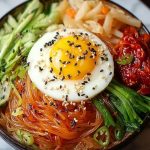
Bibimmyeon
- Total Time: 15 minutes
- Yield: 1 serving
- Diet: Vegetarian
Description
Bibimmyeon is a refreshing Korean cold noodle dish bursting with bold gochujang flavor, topped with crisp cucumbers, kimchi, and egg. This spicy Korean noodle bowl is perfect for hot days and quick dinners. Learn how to make the best Bibimmyeon with easy ingredients and storage tips!
Ingredients
1 serving Korean wheat noodles (somyeon or bibim-style)
1 ½ tablespoons gochujang (Korean red chili paste)
1 tablespoon rice vinegar
2 teaspoons soy sauce
1 teaspoon sesame oil (plus extra for noodles)
2 teaspoons sugar or honey
1 clove garlic, minced
½ cucumber, julienned
½ carrot, julienned (optional)
½ cup kimchi
1 boiled egg, halved
1 tablespoon scallions, chopped
1 teaspoon toasted sesame seeds
Instructions
1. Boil noodles according to package (3–4 minutes), then rinse under cold water to stop cooking. Toss with a little sesame oil to prevent sticking.
2. In a bowl, mix gochujang, rice vinegar, soy sauce, sugar or honey, minced garlic, and sesame oil to create the sauce.
3. Add the cold noodles to a large bowl, pour over the sauce, and toss thoroughly until evenly coated.
4. Prepare toppings: slice cucumber, carrot, and scallions; peel and halve the boiled egg.
5. Assemble the dish by placing the sauced noodles in a bowl and topping with cucumber, carrot, kimchi, egg halves, scallions, and sesame seeds.
6. Serve immediately cold. Mix everything together before eating for the best flavor.
Notes
Rinse the noodles thoroughly in ice-cold water to preserve the ideal chewy texture.
Adjust the spiciness by using more or less gochujang or adding extra honey.
For best results, toss noodles in sauce just before serving to maintain freshness.
- Prep Time: 10 minutes
- Cook Time: 5 minutes
- Category: Main Dish
- Method: No-cook assembly after boiling
- Cuisine: Korean
Nutrition
- Serving Size: 1 bowl
- Calories: 420
- Sugar: 8
- Sodium: 850
- Fat: 12
- Saturated Fat: 2
- Unsaturated Fat: 9
- Trans Fat: 0
- Carbohydrates: 63
- Fiber: 4
- Protein: 12
- Cholesterol: 93
